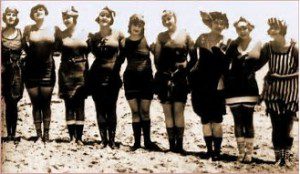
There are many ways that our current modesty rhetoric falls dreadfully short of teaching this principle correctly. We tend to focus mostly on women’s attire – instead of the much deeper meaning of the word. Both men and women should find the assertions we make about the impact women’s clothing offensive. The fact remains that fashion has changed throughout history. What has been deemed “modest” has changed throughout time, including within our own LDS standards. I have seen men and women sexually objectify others. And I have seen supposedly “immodestly” dressed women treated respectfully in many settings as well as many “modestly” dressed women ogled at.
We teach this principle incorrectly. We place responsibility incorrectly. We body shame. We objectify women as much by covering them up as we do when we undress them — when it’s done from the space of projecting our own ideas/values/judgments unto others. This happens as much in religious cultures as it happens in the media and advertising industries. And the ways I have seen many in our communities self-righteously judge others in their manner of dress (especially women), is an immodest practice all in of itself. I’m honored to have our guest writer today – an active LDS young single adult who is not letting us get away with these false teachings.
Today’s guest post is written by Josie Sherwood. Opinions shared on guest posts may not completely reflect the positions of the blog’s author.
Josie Sherwood is 18 and a sophomore at Arizona State University. In her Young Single Adults ward, she serves as choir director and pianist. She is the eldest of three siblings.
A few days ago, I was flipping through The Latter-Day Saint Woman, (the Basic Manual for Women, Part A) when I came across a troubling passage. Actually, I came across many troubling passages, but I will only focus on one in this post. On page 64, in a chapter on chastity and modesty, the book states:
We are responsible for the effect our dress standards have on others. Anything that causes improper thoughts or sets a bad example before others is not modest. It is especially important that we teach young girls not to wear clothes that would encourage young men to have improper thoughts.
The archaic assertion that women are literally “responsible” for any “effect” the way they dress has on men is astounding. Girls and women are not in any way “responsible” for the way a man thinks or behaves. The implications of this view make women culpable for the actions of men while painting men as brutish animals without self-control or accountability for their own thoughts and actions.
The first thing I did was to check and make sure the book I had was the most recent edition. It was. The manual was last updated in 2000, and is currently available on the LDS website.
I believe that this paragraph and any others that similarly assign men any less than full responsibility for their own thoughts and actions should be removed. If women are even partially to blame “for the effect [their] dress standards have on others,” then women who are victims of sexual assault, harassment, and/or rape are necessarily somehow at fault. This is wrong.
Once, I wore a dress to school. It was perfectly modest according to LDS standards. I wear it to church often. On my way to class, a group of young men followed me for a bit and made lewd comments. I was practically in tears. It didn’t matter that I was dressed modestly. Those young men chose to entertain and express their “improper thoughts” anyway, regardless of my knee-length hemlines and covered shoulders. Every day there are women in my university classes dressed in dozens of different ways, some regarded by the church as modest and some not. Most men on campus still manage to interact respectfully with them on a daily basis without regard to the way that they are dressed. In my experience, the way women are treated is not as much a reflection of their dress as it is a reflection of the individual characters and mindsets of the men around them.
The way women and girls dress does not dictate the thoughts of men and boys. Men and boys make their own choices and are responsible for themselves, their own thoughts, and their own actions. It is wrong to instruct girls to cover themselves for boys because what girls wear has nothing to do with how boys choose to see them.
The church no longer holds that women who are victims of sexual violence need to repent. In line with this current practice, women are not (and should not be) responsible for how their dress affects others. This statement in the manual is therefore inconsistent with modern church teachings.
I would replace the paragraph with a section on an attitude of modesty. In the scriptures, modesty is very often a demeanor, a humble and kind way of living. Modesty is largely about how you treat and communicate with others. But in the chapter on modesty in the manual, there was hardly anything at all about an attitude of modesty. Someone could be completely covered from the neck down, but still be entirely immodest in their manner and treatment of others. Modesty should not be (and is not in the scriptures) all about dress. It is a behavior, appearance, and manner. Modesty is much more than how we dress.
“Yea, all of you be subject one to another, and be clothed with humility: for God resisteth the proud, and giveth grace to the humble.” —1 Peter 5:5
“Yea, they were men of truth and soberness, for they had been taught to keep the commandments of God and to walk uprightly before him.” —Alma 53:21
“Behold, this was the iniquity of thy sister Sodom, pride, fulness of bread, and abundance of idleness was in her and in her daughters, neither did she strengthen the hand of the poor and needy.” —Ezekiel 16:49

As we teach and discuss modesty in the church, especially among women, I wish there was more of an emphasis on an attitude of modesty—modesty in terms of who we are rather than what we wear. The discussion of modesty is not currently gender neutral. Interestingly, a brief search on the LDS website highlights the gaping chasm between modesty for men and modesty for women in LDS culture. Searching “modest women” results in various references to “appropriate” dress, hemlines, and accepted styles of attire and grooming, while searching “modest men” generates results describing character, a lack of worldly resources, and humility. When church leaders speak about modesty to women, modesty is about the clothes they wear and how they cover their bodies. When church leaders speak about modesty to men, modesty is about their personal character and their humble acts or circumstances (i.e., a modest home). I would like to see modesty taught to girls and women not in a way that forces them to be at least partially responsible for men’s actions and pretends that men are helplessly manipulated by pieces of fabric, but rather in a way that empowers women to embrace modesty as a lifestyle and not just a dress style.
I believe that at least removing the paragraph (and other similar passages) from current church resources will be a step toward a revised curriculum that more accurately reflects the modern views of the LDS church and its members.
The front page of the book encourages readers to email their suggestions for the manual to [email protected]. I decided to send an email containing the views expressed here, and would encourage any of you who feel similarly to compose one as well. It has been 16 years since this manual and its companion had a revision, and it desperately needs one.
Natasha Helfer Parker, LCMFT, CST can be reached at natashaparker.org and runs an online practice, Symmetry Solutions, which focuses on helping families and individuals with faith concerns, sexuality and mental health. She hosts the Mormon Mental Health and Mormon Sex Info Podcasts, writes a regular column for Sunstone Magazine and is the current president of the Mormon Mental Health Association. She has over 20 years of experience working with primarily an LDS/Mormon clientele.












